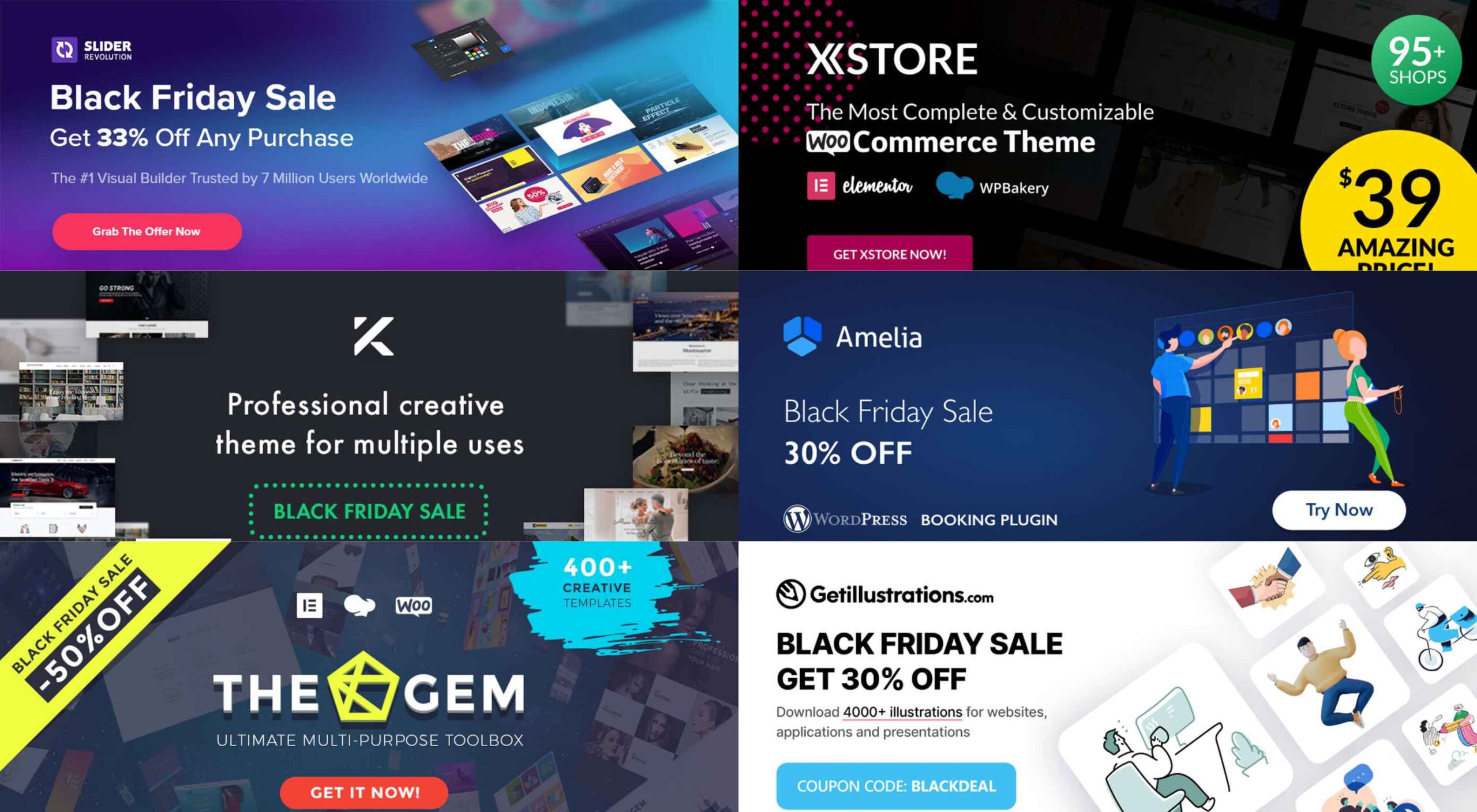Original Source: https://www.webdesignerdepot.com/2020/11/8-awesome-black-friday-2020-deals-for-designers-up-to-94-off/
 If you’re interested in a sneak peek of this year’s best Black Friday deals, stick around. You’ll find a few web designers’ favorites, including a stellar deal or two.
If you’re interested in a sneak peek of this year’s best Black Friday deals, stick around. You’ll find a few web designers’ favorites, including a stellar deal or two.
This year, more than a few of the popular retail outlets are shifting away from the traditional “camp out all night and bust open the doors when the store opens” shopping model. You might just prefer this less chaotic, ecommerce approach.
All of us are trying to adjust to what may eventually become a “new normal”. We may not like some aspects of this new normal, but there are bright spots as well.
More shoppers are likely going to shop online because of the coronavirus. That means you don’t have to fight the crowds while desperately attempting to socially distance. The shelves aren’t as apt to go bare, and shopping is easy, convenient, and safe.
1. Slider Revolution
You will find the Slider Revolution plugin incorporated in a host of WordPress theme tools and products. This premium plugin can in fact boast of more than 7 million users around the globe.
What you may not be aware of is that it is much more than just a WordPress slider. With it in your web design toolbox, you can in fact create just about anything you can imagine.
Expect to find:
A stunning selection of elements including sliders and carousels;
Attention-getting hero sections designed to make your home pages really stand out;
Single-page websites with layouts unlike anything you’ve seen before;
Modular structuring that allows you to rearrange and reuse sections however you choose and the ability to mix and match modules with any WordPress content;
Add-ons whose cutting edge features push the boundaries of web design possibilities.
There’s more of course. To celebrate Black Friday and Cyber Monday you can NOW get any Slider Revolution subscription plan or one-time payment at a 33% discount.
Just click on the banner and use the BLACKFRIDAY code at checkout.

2. Amelia
When done manually, booking and managing appointments can be tedious and subject to mistakes and errors. Amelia provides an automated booking process that is oh-so easy to work with and is error free; just what you need to help you acquire more happy customers.
Key features of Amelia’s fully responsive design include:
A dashboard system that enables you to track approved and pending appointments, booking changes, and revenue;
Zoom Integration, Google Calendar, and Outlook Calendar sync;
The ability to accept and easily manage recurring appointments that customers can schedule;
Front-end customer and employee appointment and event managing and backend appointment adding, editing, and rescheduling;
Email notifications for pending and approved appointments and events.
And much more that will save you loads of energy and a ton of time. Give Amelia a try, and if you like what you see (and you will), take advantage of the 30% Black Friday discount.

3. wpDataTables
wpDataTables 3.0, with its fresh, new look, gives you a host of different ways to generate attractive, customizable, and responsive tables and charts, and a host of different ways to present them.
Tables can be created from most data sources, the most common being MySQL query, PHP array, Google Spreadsheet, Excel files CSV files, and JSON and XML inputs;
A working knowledge of SQL is not required!
Addons include Gravity Forms, Formidable Forms, Report Builder, and Powerful Filter;
wpDataTables users can generate Tables and Charts quickly from massive amounts of data (saving hours of effort);
Tables and charts are customizable and maintainable (editable once placed in use);
Tables can be created manually if you wish.
Click on the banner now and take advantage of wpDataTables 30% Black Friday discount on all licenses and addons.

4. TheGem – Creative Multi-Purpose High-Performance WordPress Theme
In TheGem, the ultimate WordPress multipurpose toolbox, you will find:
A rich selection of 400+ premium pre-built multi-page and one-page websites, all available for Elementor and WPBakery page builders;
The ability to mix and match any of this demos, layouts and page sections to create your own unique look;
Extended WooCommerce layouts & tools for making online shops, which convert better;
TheGem Blocks: an ultimate tool for building webpages at the speed of light.
And much more. Just click on the banner and check this 5-star product out.

5. Mobirise Website Builder
Creating a Google-friendly can take time, unless you have Mobirise at your fingertips, in which case you have a number of helpful tools to speed things up.
No coding, it’s all drag and drop;
3,600+ website templates are at your disposal plus sliders, popups, forms, and more;
Many eCommerce features, including a shopping cart;
Latest Google Amp and Bootstrap4;
You can download Mobirise for free.
And, because it’s Black Friday, everything is yours at a 94% discount!

6. Get Illustrations
Get Illustrations offers royalty free and landing page Illustrations ready to drag and drop into your web design. You’ll have access to:
An extensive library of 4000+ illustrations with more added every week;
A wealth of design formats, including AI, PNG, SVG, Figma, Adobe XD, and Sketch;
Free updates and new illustrations weekly (included in the bundle).
Click on the banner and use the Coupon Code BLACKDEAL for your 30% discount.

7. XStore | Responsive Multi-Purpose WooCommerce WordPress Theme
For anyone planning on creating an eCommerce store, the XStore name says it all. Key features you’ll find in this powerful and flexible WooCommerce theme include:
More than 95 good-to-go-shops plus a full AJAX shop to get you started;
300+ pre-defined shop/page sections, a header builder, and a single product page builder;
Elementor, WPBakery and $510+ worth of premium plugins.
Click on the banner and sign up to become one of XStore’s 55,000+ happy customers.

8. Kalium – Creative Theme For Multiple Uses
Kalium is an easy-to-use, easily maintainable multipurpose theme for WordPress users that is always updated to use the latest WordPress standards.
Kalium provides its users with a host of professionally-designed pre-built demos and elements;
Many plugins such as: Slider Revolution, WPBakery, Elementor, Layer Slider, Advanced Custom Fields PRO, Product Filter for WooCommerce, Product Size Guide,WooCommerce and other premium plugins are included.
Kalium is responsive, GDPR compliant, and gives you full eCommerce and top-quality customer support. It has a 5-star rating after 36k sales on ThemeForest – seriously impressive!

*****
If you hit the retail stores remember to social distance.
Or, if you would rather take a brief break from the demands of Covid-19, take advantage of one or more of the above ecommerce sales. As you can see, there are some excellent ones!
[– This is a sponsored post –]
Source
p img {display:inline-block; margin-right:10px;}
.alignleft {float:left;}
p.showcase {clear:both;}
body#browserfriendly p, body#podcast p, div#emailbody p{margin:0;}



 If you’re interested in a sneak peek of this year’s best Black Friday deals, stick around. You’ll find a few web designers’ favorites, including a stellar deal or two.
If you’re interested in a sneak peek of this year’s best Black Friday deals, stick around. You’ll find a few web designers’ favorites, including a stellar deal or two.























































 Since there are so many CMS plugins out there, it can be overwhelming to choose the best ones for your website. We’ve done the research for you; this list contains the top new CMS plugins for November 2020. You’ll find useful plugins for WordPress, Craft, Shopify, and Joomla.
Since there are so many CMS plugins out there, it can be overwhelming to choose the best ones for your website. We’ve done the research for you; this list contains the top new CMS plugins for November 2020. You’ll find useful plugins for WordPress, Craft, Shopify, and Joomla.

